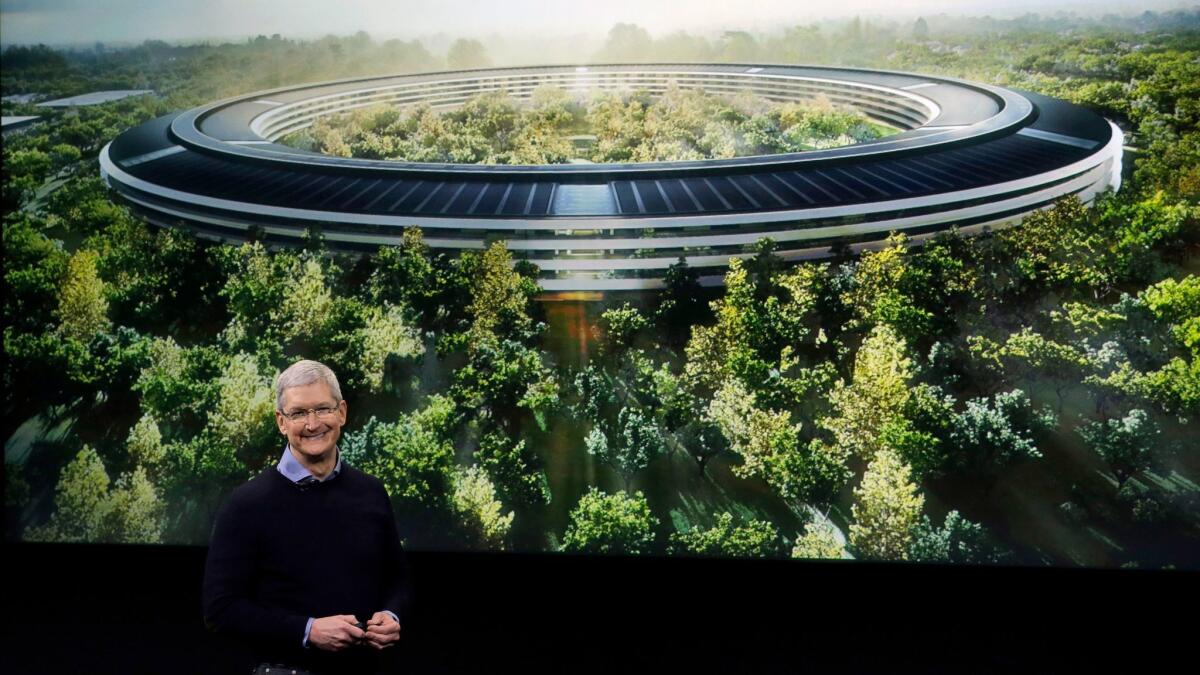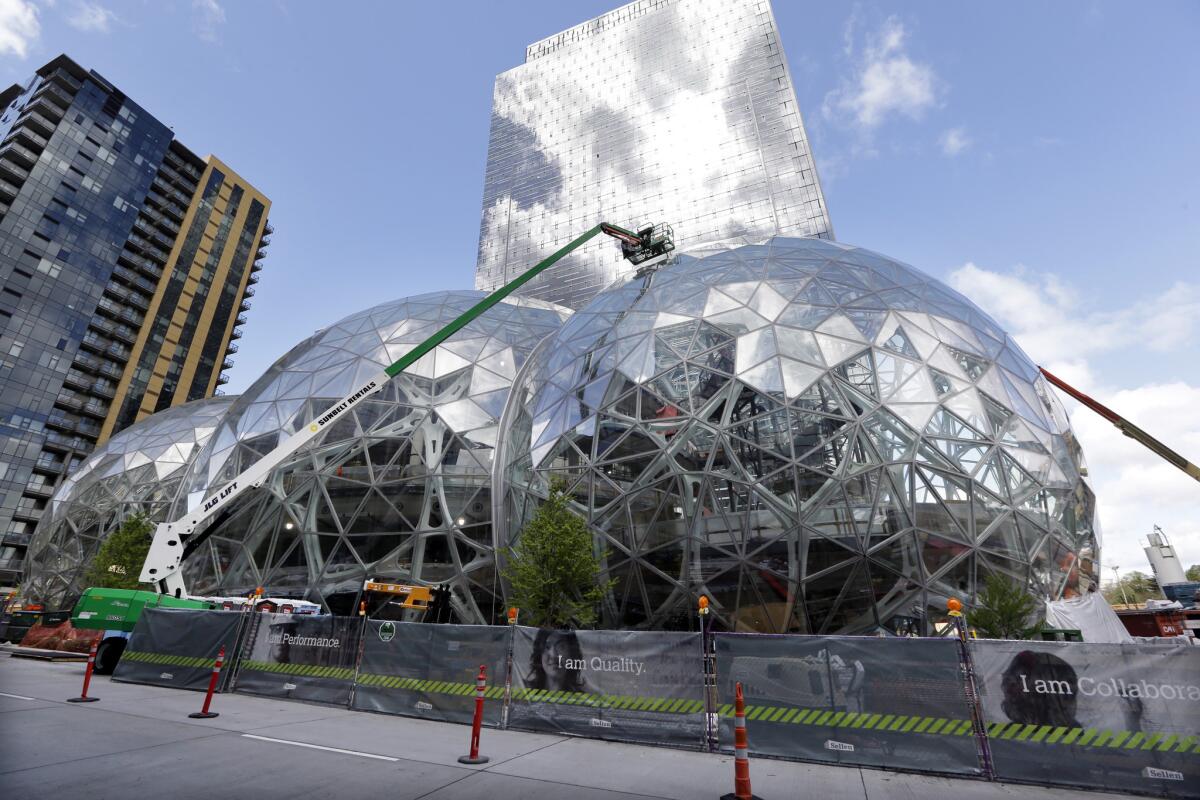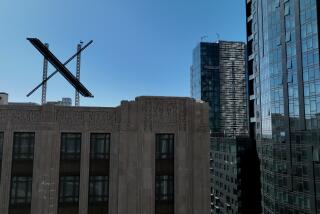Column: Apple and Amazon take two paths to the same conclusion — that tech companies owe nothing to the American city

- Share via
In journalism, the competition to pick the new editor of a magazine or newspaper is often called a “bakeoff.” (The oven is now on preheat at Vanity Fair, following the announcement that Graydon Carter, the magazine’s editor since 1992, will step down at the end of the year.) It also seems a pretty good way to describe the unusually public process Amazon and its founder, Jeff Bezos, have cooked up to select the city where it will locate a second headquarters, building on its existing presence in Seattle.
Amazon’s criteria for the new campus — which it says will cost $5 billion and create 50,000 jobs with an average annual salary of more than $100,000 — are highly specific. The company has said contending cities must be part of a metro region with a population of more than a million, be located near major universities and an international airport and have a stable business climate along with a deep pool of highly educated workers.
There’s already been significant debate among economists and urban planners about whether it makes sense for cities to court Amazon, especially if the competition heats up so much that the winner winds up offering big tax breaks and other incentives it may not entirely be able to afford. Cities have shown no such ambivalence: They are lining up to take part.
Amazon is framing its campaign to build a second headquarters first as a sort of stress test of competing cities — and perhaps of American urbanism itself.
Simply by announcing that it plans to invest heavily in a second American city, Amazon has set itself apart from its competitors. Most American tech giants have remained true to the deeply suburban roots of a field whose origin stories often feature two-car garages on quiet streets as the backdrops for ingenious breakthroughs in personal computing. Amazon is framing its campaign to build a second headquarters first as a sort of stress test of competing cities — and perhaps of American urbanism itself — and then as an investment in one of them.
In doing so it is distancing itself from one fellow tech behemoth in particular: Apple. One of the last projects Steve Jobs worked on before his death in 2011 was a new campus for the company in Cupertino, Calif. Designed by the British firm Foster and Partners and known as Apple Park, it is a circular building chiseled out of curving glass and set carefully into a lush garden: the very picture of Arcadian distance from, if not distrust of, the big city. The 175-acre campus, which includes parking for 11,000 cars, is essentially complete; on Tuesday Apple held the first major event in its Steve Jobs Theater, unveiling new iPhone models, among other products.
Plans for Apple Park were probably too far along at the time of Jobs’ death for his successor, Tim Cook, to pull the plug even had he wanted to. It would have taken a remarkable amount of courage for Cook, just after taking over for Jobs, a much feared and respected figure if not a much loved one, to reverse course on his predecessor’s pet project. And yet by staying the course on Apple Park the company has built an exquisite monument to Jobs, as opposed to a place for the future Apple to define itself.
The stubbornness of Cook’s fidelity to a set of ideas that will always be associated with Jobs has been a remarkable thing to watch. It has also been remarkable to watch Amazon pursue a dramatically different strategy. Its plans for a second headquarters suggest that in terms of architecture and campus planning it wants to be everything Apple is not. It wants to lean into the city — and thorny questions about gentrification and housing prices, to the extent that they will be a natural byproduct of this process — rather than away from it.

SIGN UP for the free Essential Arts & Culture newsletter »
It’s possible of course that Amazon, after sifting through proposals from cities across the country, will settle on a location that is not quite fully urban. But if its ongoing expansion in Seattle (designed by the firm NBBJ) is any indication, Amazon and Bezos are committed to locations inside cities rather than suburban or exurban ones.
Ultimately, however, Amazon’s bakeoff suggests an attitude about American cities and their needs that isn’t so different from Apple’s. Amazon has essentially guaranteed that it will be taking hefty tax breaks with one hand while it makes a show of committing to a lucky American metropolis with the other. Apple for its part has had an exceptionally willing partner in Cupertino.
If a more synergistic relationship were his goal, Bezos might have picked a winner first and then settled on a specific location second, working to make sure the arrangements boosted both company and city. The bakeoff, though, will surely earn him a better deal.
Though he took a very different path to get there, Bezos ultimately reached the same conclusion Jobs did: that the wealthiest and most powerful tech companies owe nothing to the American city.
That doesn’t mean they won’t continue to rely on it for a ready supply of metaphors. At the event on Tuesday, Apple introduced a new concept for its retail stores. Angela Ahrendts, senior vice president of retail and online stores, said they would be now be called Town Squares.
It’s a telling two-word phrase. It suggests that while Apple itself has no desire to be in a city, it certainly wants its customers to think they are.
Building Type is Christopher Hawthorne’s weekly column on architecture and cities. Look for future installments every Thursday at latimes.com/arts.
Twitter: @HawthorneLAT
MORE ARCHITECTURE:
Credit where it’s due: Remembering Gin Wong
MoMA’s love-hate relationship with Frank Lloyd Wright
John Yeon, unsung master of Pacific Northwest modernism
Disneyland meets Hogwarts at $700-million USC Village
More to Read
The biggest entertainment stories
Get our big stories about Hollywood, film, television, music, arts, culture and more right in your inbox as soon as they publish.
You may occasionally receive promotional content from the Los Angeles Times.











